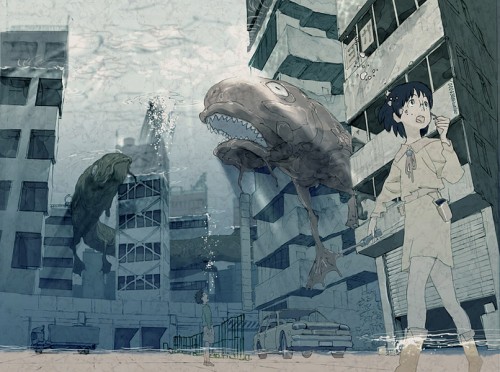This post is a part of a series covering my qualifying exam research areas. Scroll to the bottom of this post for links to each area, or click here for a general description of the process.

Description
As devices and platforms multiply, so too does the amount of metadata produced by individuals in the course of daily life. This metadata, generated and collected via disparate sources such as social networking profiles, web usage analytics, and physical sensor systems embedded in mobile devices and the built environment, provides interaction designers with rich real-time information flows that model and visualize user behavior.
Understanding how to create responsive and context-aware interactivity based on these dynamic data flows is an imperative for designers working in the field of social media and pervasive computing interaction design. Equally important is an investigation of how participatory activities and games – from social games to ambient alternate reality games to locative artworks to collaborative production games and more – can leverage social media and pervasive computing to exist “inside the flow” of their users’ lives, rather than as cordoned-off activities that necessitate a pause or “stepping out” from behavioral norms in order to access. Key readings draw from game design, particularly discussions around so-called “casual” asynchronous play systems (Fullerton, Juul, Salen and Zimmerman); mobile and locative interaction design (Böhlen and Frei, Ermi, Montola, Schell, Vinge); information architecture, pervasive computing, and the internet of things (Benford, Berners-Lee, Bleecker, Kay, Krueger, Montola, Nieuwdorp, Shirky, Sterling); and human-computer interaction design (Csikszentmihalyi, Kuniavsky, Thackara, Ramsey, Simon).
Bibliography
Benford, Steve et al. “Bridging the physical and the digital in pervasive gaming,” Communications of the ACM, 48 (3), 54-57, 2005.
Berners-Lee, Tim. “Linked Data – Design Issues.” http://www.w3.org/DesignIssues/LinkedData.html
Bleecker, Julian, and Nicolas Nova. “A synchronicity: Design Fictions for Asynchronous Urban Computing.” Situated Technologies. http://www.situatedtechnologies.net/?q=node/102
Bogost, Ian. “Asynchronous Multiplay: Futures for Casual Multiplayer Experience.” http://www.bogost.com/writing/asynchronous_multiplay_futures.shtml
______. “Cow Clicker.” http://www.bogost.com/blog/cow_clicker_1.shtml
Böhlen, Marc, and Hans Frei. “MicroPublicPlaces.” Situated Technologies. http://www.situatedtechnologies.net/?q=node/104
Csikszentmihalyi, Mihaly. Flow: The Psychology of Optimal Experience. 1st ed. Harper Perennial Modern Classics, 2008.
Dourish, Paul. “Embodied Interaction: Exploring the Foundations of a New Approach to HCI.” Xerox PARC, 1999. http://www.dourish.com/embodied/embodied99.pdf
______. Where the Action Is: The Foundations of Embodied Interaction. MIT Press, 2001.
Ermi, Laura and Mayra, Frans. “Player-Centered Game Design: Experiences in Using Scenario Study to Inform Mobile Game Design.” Game Design Research Symposium, IT-University, 2004. http://www.gamestudies.org/0501/ermi_mayra/
Fullerton, Tracy. Game Design Workshop, Second Edition: A Playcentric Approach to Creating Innovative Games. 2nd ed. Morgan Kaufman, 2008.
IGDA Casual Games SIG. 2008-2009 Casual Games White Paper. International Game Developers Association, 2009. http://archives.igda.org/casual/IGDA_Casual_Games_White_Paper_2008.pdf
Juul, Jesper. A Casual Revolution: Reinventing Video Games and Their Players. The MIT Press, 2009.
Kay, Alan and Goldberg, Adele. “Personal Dynamic Media,” The New Media Reader. MIT Press, 2003.
Korhonen, Hannu, Hannamari Saarenpää, and Janne Paavilainen. “Pervasive Mobile Games — A New Mindset for Players and Developers.” In Proceedings of the 2nd International Conference on Fun and Games, 21-32. Eindhoven, The Netherlands: Springer-Verlag, 2008.
Krueger, Myron W. “Responsive Environments,” in Wardrip-Fruin, Noah and Montfort, Nick (ed.) The New Media Reader. MIT Press, 2003.
Kuniavsky, Mike. Observing the User Experience: A Practitioner’s Guide to User Research. 1st ed. Morgan Kaufmann, 2003.
Montola, Markus, Jaakko Stenros, and Annika Waern. Pervasive Games: Theory and Design. Morgan Kaufmann, 2009.
Nieuwdorp, Eva. “The Pervasive Interface: Tracing the Magic Circle,” Proceedings of DiGRA Conference: Changing Views–Worlds in Play, 2005.
Ramsey, Jim. “Designing For Flow.” A List Apart, December 4, 2007. http://www.alistapart.com/articles/designingforflow/
Salen, Katie, and Eric Zimmerman. Rules of Play: Game Design Fundamentals. Illustrated edition. The MIT Press, 2003.
Schell, Jesse. DICE 2010: Design Outside the Box, 2010. http://g4tv.com/videos/44277/dice-2010-design-outside-the-box-presentation/
Shirky, Clay. Letter. “Situated Software,” March 30, 2004. http://www.shirky.com/writings/situated_software.html
Simon, Nina. “Going Analog: Translating Virtual Learnings into Real Institutional Change.” In Archives & Museum Informatics: Museums and the Web 2009. Indianapolis, Indiana, USA, 2009.
Stein, Jennifer, Fisher, Scott, and Otto, Greg. “Connecting and Animating the Built Environment with the Internet of Things.” Internet of Things Workshop, 2010.
Sterling, Bruce. Shaping Things. The MIT Press, 2005.
Thackara, John, ed. Design After Modernism: Beyond the object. Gloucester: Thames and Hudson, 1988.
______. In the Bubble: Designing in a Complex World. Cambridge, Mass: MIT Press, 2005.
Vinge, Vernor. Rainbows End. Tor Books, 2007.
Qualifying Exam Areas
I’ve also written a brief post on the ongoing role that this website is playing in my research:
Finally, you can download the latest version of my exam area descriptions and bibliographies in .pdf form here.

